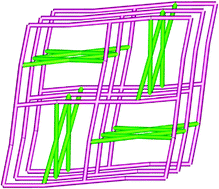Metal–organic frameworks constructed from mixed-ligand1,2,3,4-tetra-(4-pyridyl)-butane and benzene-polycarboxylate acids: syntheses, structures and physical properties†‡
Abstract
Three novel coordination ![[1 with combining macron]](https://www.rsc.org/images/entities/char_0031_0304.gif) 11] direction via strong interlayer π⋯π interactions to form a 3D supramolecular architecture. Complex 2 has a 3D complicated framework comprised of two kinds of infinite 1D chains. The 3D framework of complex 3 possesses three topologically nonequivalent 4-connected nodes synchronously and exhibits an unprecedented (64·102)(42·84)(4·65)2 topology. The magnetic susceptibility data of complex 1 show strong antiferromagnetic interactions in the dinuclear Mn(II) units. Complex 2 exhibits strong fluorescent emissions in the solid state at room temperature and may be suitable as a candidate of blue-fluorescent material.
11] direction via strong interlayer π⋯π interactions to form a 3D supramolecular architecture. Complex 2 has a 3D complicated framework comprised of two kinds of infinite 1D chains. The 3D framework of complex 3 possesses three topologically nonequivalent 4-connected nodes synchronously and exhibits an unprecedented (64·102)(42·84)(4·65)2 topology. The magnetic susceptibility data of complex 1 show strong antiferromagnetic interactions in the dinuclear Mn(II) units. Complex 2 exhibits strong fluorescent emissions in the solid state at room temperature and may be suitable as a candidate of blue-fluorescent material.


 Please wait while we load your content...
Please wait while we load your content...